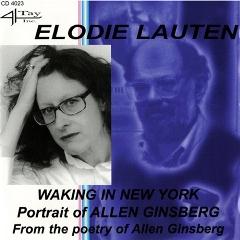Elodie Lauten – Waking In New York: Portrait Of Allen Ginsberg (2003)
Elodie Lauten – Waking In New York: Portrait Of Allen Ginsberg (2003)

Act I 1 May Days 1988/Part I: Day After Day 6:04 2 May Days 1988/Part II: How Many More Years 7:06 3 Lunchtime (Meredith Borden) 3:10 4 The Charnel Ground/Part I: See The Supervisor 6:46 5 The Charnel Ground/Part II: Giving Away The Giver 5:28 Act II 6 Personal Ads 3:39 7 Jumping The Gun On The Sun 3:40 8 Manhattan Thirties Flash 3:21 9 Song: The Weight Of The World Is Love (Sherrita Duran) 6:37 10 Waking New York/Part I: O New York 6:35 11 Waking In New York/Part II: Out Of The Womb 9:53 12 Waking In New York/Part III: Well Come & Be Balm 3:48 Baritone Vocals – Mark Duer Cello – Andrei Tchekmazov Contrabass – Rafael Agudelo Drums – Bill Ruyle Flute – Ulla Suokko Percussion – Mustafa Ahmed Soprano Vocals – Meredith Borden, Sherrita Duran, Tyler Azelton Text By – Allen Ginsberg Viola – Tania Askins Violin – Grigory Kalinovsky, Jaram Kim Music By, Producer, Synthesizer – Elodie Lauten
WAKING IN NEW YORK is about experiencing daily life in New York through the eyes of Ginsberg, pictured in the later part of his life. From his apartment in the East Village, he tells everything about his state of mind, his body, his food, his work, his political causes - the Middle East, the death penalty, peace - all in the same breath. He is in a constant dialogue with his muses, Freedom and Compassion. He tells stories about the real people in his neighborhood, from the junkies and the homeless to the yuppies. Ginsberg expresses his love of life in a down-to-earth, occasionally satirical vision of the world, alternating with moments of deep emotion and classic lyricism. There is an uplifting element in Ginsberg's tolerant and all-inclusive vision of the city with its exciting jaggedness, its energy. Elodie Lauten met Ginsberg in 1973 when at 22, she first came to New York. She stayed at his East Village apartment, and occasionally accompanied him in his public readings. He introduced her to Buddhism with the chanting of mantras and meditation and became somewhat of a mentor. In her setting, she closely followed Allen's train of thought, alternatively introspective and expansive, edgy, playful or lyrical, sometimes triggering hints of different musical styles and unexpected chord changes. Because of her deep understanding of Ginsberg's personality and philosophy, she felt strongly about a melodic setting as opposed to narrative over music, as others had done before: in Waking in New York, every word is sung, even the most unlikely. ---elodielauten.net
Elodie Lauten was born in Paris in 1950, the daughter of jazz musician Errol Parker, and came to New York 1973 when she was 'discovered' by poet Allen Ginsberg and encouraged in her already precocious excitement for sonic invention. She went to New York University, learnt a lot from LaMonte Young and others, married, became a Buddhist, and is the inspiration for dance and concert events, sound installations and the staging of operatic presentations, workshops and collaborations with instrumentalists and librettists. She has a formidable list of work which includes some curiously esoteric articles.
Her most recent piece was the première at the Willow Place Auditorium, Brooklyn of Symphony 2001 in its revised and unabridged version. This is a joyful nineteen-minute orchestral celebration of the Millennium in Sioux songs, mystery, magic, Buddha, making light of the dark predictions of Nostradamus, and building seven very brief movements from correspondences between colours and their sound frequencies.
Close on its heels follows the subject of this CD review, Waking in New York, a flow of Allen Ginsberg's introverted thoughts and impressions compiled only six months before his death, and made into a kind of Two Act musical by Elodie Lauten, with singers Mark Duer as Ginsberg, Meredith Borden as Compassion, with Tyler Azelton and Sherrita Duran as the two faces of Freedom. Lauten is described as a leading light of postminimalism, and this piece seems to be doing something like that, a minimal approach to word setting, harmonic structuring, instrumental colour and even the text itself.
For a short time its fascination is mesmerising, but neither music nor text are quite Sondheim, and only a strong personal enthusiasm or connexion would stimulate concentration for over an hour on this recording. It could be better live, and it does make one curious about other works (like that Symphony 2001), but on CD its mechanical syllabic setting, show-style vocals and instrumental constraint creates a longing for greater subtle invention [listen -- track 3, 0:00-1:00]. The Lauten website is, however, quite a revelation. ---Patric Standford, mvdaily.com
download (mp3 @192 kbs):
yandex mediafire ulozto gett bayfiles








